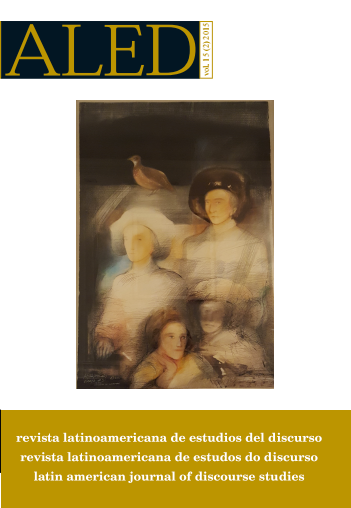Las funciones informativas en géneros de la comunicación especializada
Keywords:
hanging topics. dislocated topics. focalization. academic genres.Abstract
Word order may be modified with discursive purposes. In the case of marked-order sentences, the theme is embodied in grammatical devices, such as hanging topics and dislocated topics (Zubizarreta 1999, Bosque y Gutiérrez Rexach 2008). Such orderings are particularly relevant in discourse with respect to thematic prominence or information relevance. Besides, they have specific grammatical restrictions. The aim of this study is to analyze how information structures work in two specialized communication genres, and to establish relationships between information structures and textual functions in the academic genres under analysis. Our hypothesis is that information structures provide instructions for making inferences that help comprehension. The corpus consists of research papers and editorials from Medicina, an Argentinian medical journal of longstanding renown.
Downloads
References
Benveniste, C. 1994. Approches de la langue parlee en francais. Paris: Ophrys.
Blakemore, D. 1992. Understanding utterances. An introduction to pragmatics. Oxford/ Cambridge: Blackwell.
Borreguero Zuloaga, M. 2014. Left periphery in discourse. En A. Dufter y A. Octavio de Toledo (eds.). Left sentence peripheries in Spanish, pp. 309-342. Amsterdan/ Philadelphia: John Benjamins Publishig Company.
Bosque, I. y Gutiérrez Rexach, J. 2008. Fundamentos de sintaxis formal. Madrid: Akal.
Di Tullio, A. 2005. Manual de gramática del español. Buenos Aires: La isla de la luna.
Escandell Vidal, V. 2000. Sintaxis y uso interpretativo. En K. Korta y F. García Murga (comps.). Palabras. Víctor Sánchez de Zavala. In memorian, pp. 219- 259. Bilbao, Servicio de Publicaciones de la Universidad del País Vasco.
Escandell Vidal, V. y Leonetti, M. 2014. Fronting and irony in Spanish. En A.
Dufter. y A. Octavio de Toledo (eds.). Left sentence peripheries in Spanish, pp. 309-342. Amsterdan/ Philadelphia: John Benjamins Publishing Company
Ferrari, A. Cignetti, L., De Cesare, A., Lala, L., Mandelli, M., Ricci, C. y Roggia, E. 2008. L’interfaccia lingua-testo. Natura e funzioni dell’articolazione informativa dell’enunciato. Alessandria: Edizioni dell’Orso.
Ferrari, L. 2011. [Disponible en https://sites.google.com/site/grupoeise/jornadas] Las funciones informativas y la escritura. En D. Riestra (comp.). Segundas Jornadas internacionales de investigación y prácticas en didáctica de las lenguas y las literaturas, pp. 28-38. Viedma: Universidad Nacional de Río Negro, Geise E book [acceso: 12-06-2015]
Firbas, J. 1992. Functional sentence perspective in written and oral communication. Cambridge: Cambridge University Press.
Halliday, M. y Matthiessen, C. 2004. An introduction to functional grammar. London: Arnold.
Moreno Cabrera, J.C. 1999. Las funciones informativas: las perífrasis de relativo y otras construcciones perifrásticas. En I. Bosque y V. Demonte (eds.). Gramática descriptiva de la lengua española, Vol. 3, pp.4245-4304. Madrid: Espasa Calpe.
Leonetti, M. y Escandell-Vidal, V. 2010. Las anteposiciones inductoras de foco de polaridad. En E. V. Castel y L. Cubo de Severino (eds.). La renovación de la palabra en el bicentenario de la Argentina. Los colores de la mirada lingüística, pp. 733-743. Mendoza: Editorial FFyL, UNCuyo.
Real Academia Española. 2009. Nueva gramática de la lengua española. Madrid: Espasa Libros.
Rodríguez Ramalle, T. 2005. Manual de sintaxis del español. Madrid: Castalia.
Roulet, E. Filliettaz, L., Grobet, A., (con la colaboración de Marcel Burger). 2001. Un modele et un instrument d’analyse de l’organisation du discours. Bern: Peter Lang.
Sperber, D, y Wilson, D. 1986. Relevance: Communication and cognition. Cambridge MA: Blackwell, Oxford and Harvard University Press.
Zubizarreta, M. L. 1999. Las funciones informativas: tema y foco. En: I. Bosque y V. Demonte (eds.). Gramática descriptiva de la lengua española, Vol.3, pp. 4215 4244. Madrid: Espasa Calpe.
Downloads
Published
How to Cite
Issue
Section
License

This work is licensed under a Creative Commons Attribution-NonCommercial-NoDerivatives 4.0 International License.
The authors retain the copyright and guarantee RALED the right to be the first publication of the work as well as a Creative Commons Attribution License that allows others to share the work with recognition of authorship and the initial publication in this journal.




